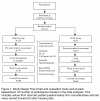A randomised controlled trial of a self-management education program for osteoarthritis of the knee delivered by health care professionals
- PMID: 22284848
- PMCID: PMC3392814
- DOI: 10.1186/ar3703
A randomised controlled trial of a self-management education program for osteoarthritis of the knee delivered by health care professionals
Abstract
Introduction: Our aim in the present study was to determine whether a disease-specific self-management program for primary care patients with osteoarthritis (OA) of the knee (the Osteoarthritis of the Knee Self-Management Program (OAK)) implemented by health care professionals would achieve and maintain clinically meaningful improvements in health-related outcomes compared with a control group.
Methods: Medical practitioners referred 146 primary care patients with OA of the knee. Volunteers with coexistent inflammatory joint disease or serious comorbidities were excluded. Randomisation was to either a control group or the OAK group. The OAK group completed a 6-week self-management program. The control group had a 6-month waiting period before entering the OAK program. Assessments were taken at baseline, 8 weeks and 6 months. The primary outcomes were the results measured using the Western Ontario and McMaster Universities Arthritis Index (WOMAC) Pain and Function subscales on the Short Form 36 version 1 questionnaire (SF-36) Secondary outcomes were Visual Analogue Scale (VAS) pain, Timed Up & Go Test (TUG), knee range of motion and quadriceps and hamstring strength-isometric contraction. Responses to treatment (responders) and minimal clinically important improvements (MCIIs) were determined.
Results: In the OAK group, VAS pain improved from baseline to week 8 from mean (SEM) 5.21 (0.30) to 3.65 (0.29) (P ≤ 0.001). During this period, improvements in the OAK group compared with the control group and responses to treatment were demonstrated according to the following outcomes: WOMAC Pain, Physical Function and Total dimensions, as well as SF-36 Physical Function, Role Physical, Body Pain, Vitality and Social Functioning domains. In addition, from baseline to week 8, the proportion of MCIIs was greater among the OAK group than the control group for all outcomes. For the period between baseline and month 6, WOMAC Pain, Physical Function and Total dimensions significantly improved in the OAK group compared to the control group, as did the SF-36 Physical Function, Role Physical, Body Pain, Vitality and Social Functioning domains, as well as hamstring strength in both legs. During the same period, the TUG Test, range of motion extension and left-knee flexion improved compared with the control group, although these improvements had little clinical relevance.
Conclusions: We recorded statistically significant improvements compared with a control group with regard to pain, quality of life and function for participants in the OAK program on the basis of WOMAC and SF-36 measures taken 8 weeks and 6 months from baseline.
Figures

Comment in
-
Arthrose.Orthopade. 2012 Nov;41(11):923-4. doi: 10.1007/s00132-012-1975-y. Orthopade. 2012. PMID: 23135376 German. No abstract available.
References
-
- March L, Bagga H. Epidemiology of osteoarthritis in Australia. Medical Journal of Australia. 2004;180:S6–10. - PubMed
-
- Access Economics. Painful Realities: The economic impact of arthritis in Australia in 2007. Canberra: Arthritis Australia; 2007.
-
- Kadam U, Croft P. Clinical comorbidity in osteoarthritis: Associations with physical function in older patients in family practice. Journal of Rheumatology. 2007;34(9):1899–1904. - PubMed
-
- Chodosh J, Morton S, Mojica W, Maglione M, Suttorp M, Hilton L, Rhodes S, Shekelle P. Meta-analysis: chronic disease self-management programs for older adults. Annals of Internal Medicine. 2005;143:427–438. - PubMed
-
- Hurley MV, Walsh NE, Mitchell HL, Pimm TJ, Patel A, Williamson E, Jones RH, Dieppe PA, Reeves BC. Clinical effectiveness of a rehabilitation program integrating exercise, self-management, and active coping strategies for chronic knee pain: a cluster randomized trial. Arthritis & Rheumatism. 2007;57(7):1211–1219. doi: 10.1002/art.22995. - DOI - PMC - PubMed
Publication types
MeSH terms
LinkOut - more resources
Full Text Sources

